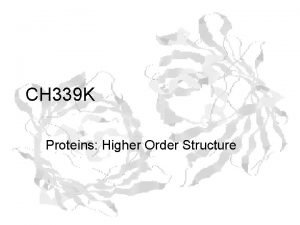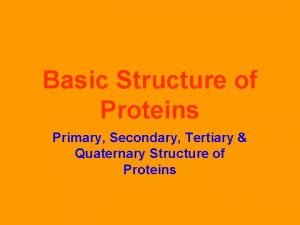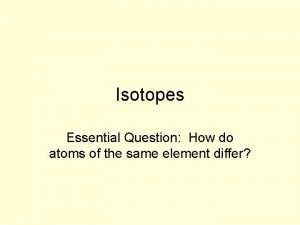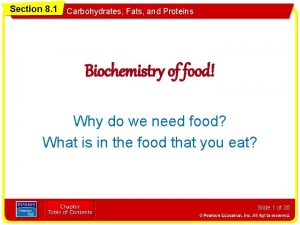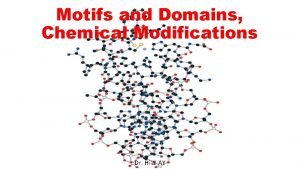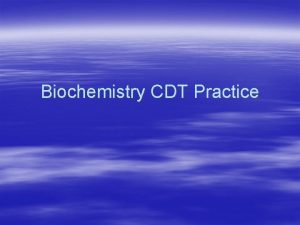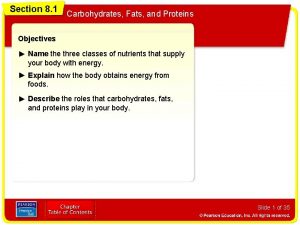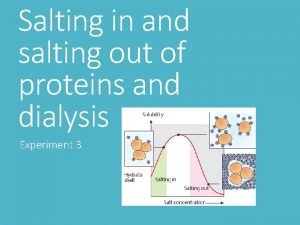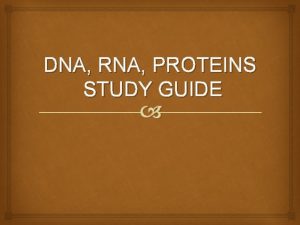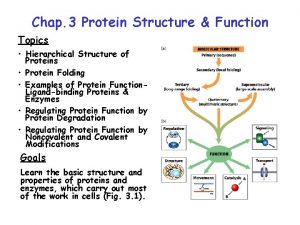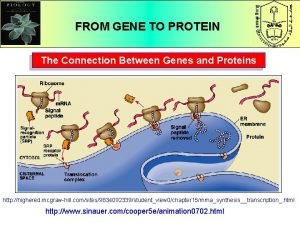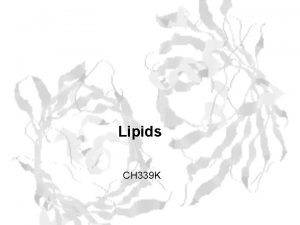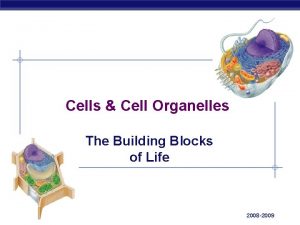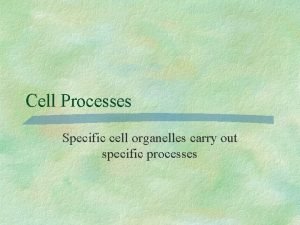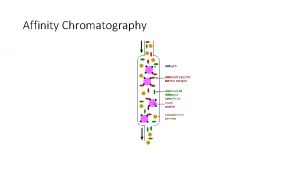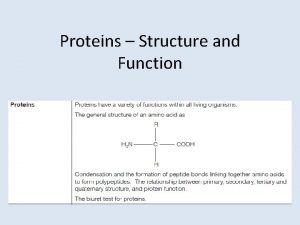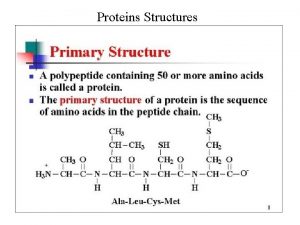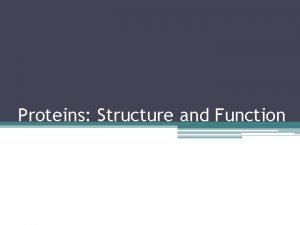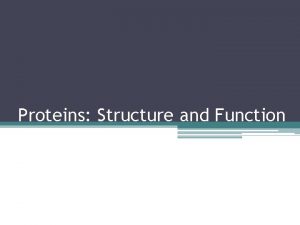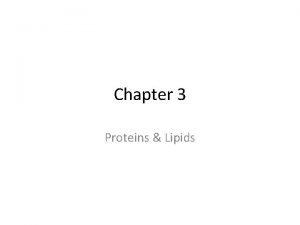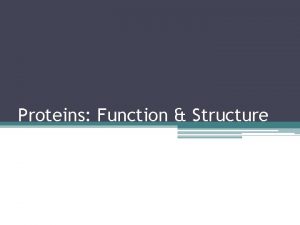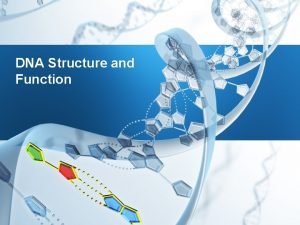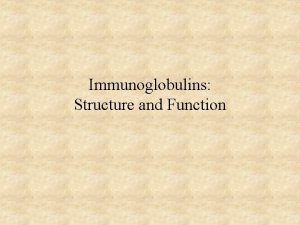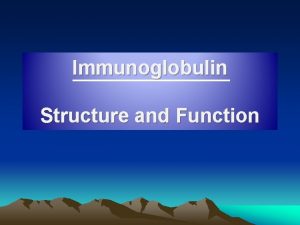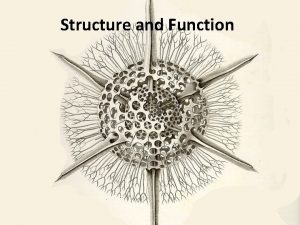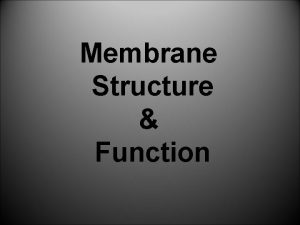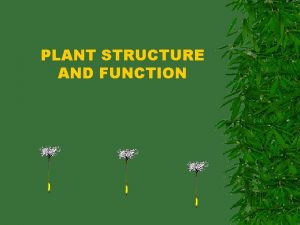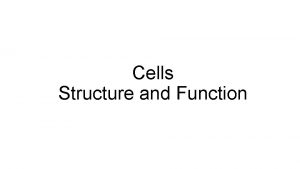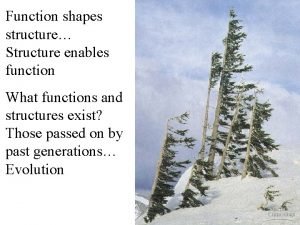Proteins Structure and Function PROTEINS Proteins are essential
























- Slides: 24

Proteins Structure and Function

PROTEINS Proteins are essential to the structures and activities of life • A protein is a polymer constructed from amino acid monomers • The structure of the protein determines its function. • Most versatile macromolecules in our cells

Protein Functions The seven major functions of protein are 1) Structural: hair, cell cytoskeleton 2) Contractile: producers of movement in muscle and other cells 3) Storage: sources of amino acids, such as egg white 4) Defense: antibodies, membrane proteins 5) Transport: membrane proteins on cell membrane, carrier molecules such as hemoglobin (carry O 2 and CO 2) 6) Signaling: hormones, membrane proteins 7) Enzymes: regulators of the speed biochemical reactions

Amino acids • Monomeric subunit of polypeptides (proteins) • Have amino group and carboxyl group • Protein diversity is based on different arrangements of a common set of 20 amino acid monomers • differently

• 20 natural amino acids – Each has different R group (20 different “R” groups) – Differences in R group makes amino acids react • The structure of the R group determines the specific properties of each amino acid Properties defined by R-group include: – Polarity (non-polar, polar or charged) – Acidity (acidic, basic, neutral) – Soluble (hydrophillic, hydrophobic)

Essential Amino Acids • Humans can not synthesize them; they are dietary requirements (there are 8)


• proteins = peptides (short proteins) or polypeptides (long proteins) • Cells link amino acids together by dehydration synthesis • The bonds between amino acid monomers are called peptide bonds • Dipeptides are two amino acids long; polypeptides are from several to more than a thousand amino acids long Carboxyl group Amino acid Amino group Amino acid Peptide bond Dehydration reaction Dipeptide

Synthesis of Polypeptides • Polypeptide is synthesized by dehydration reaction • Chain grows from amino terminus to carboxy terminus • Chain has a repetitive backbone with variable side groups • R groups frequently interact with others

A protein's specific shape determines its function • • The order of amino acids determines which R groups will be able to interact and allow the protein to fold and coil in a unique way. This unique folding gives each protein their specific function. A protein consists of one or more polypeptide chains spontaneously folded into a unique shape The folding of a polypeptide creates grooves that enable other molecules to bind to it

LE 3 -13 Groove

A protein's shape depends on four levels of structure • • Primary structure Secondary structure Tertiary structure Quaternary structure

Primary Structure • Sequence of amino acids within a single polypeptide • amino acids linked by the peptide bond • dictates the final 3 dimensional shape of a protein • Are often similar among proteins of similar function • Usually written from amino terminus to carboxy terminus

Secondary Structure • Localized within regions of polypeptide • Stabilized by hydrogen bonding between the polar R groups • a helix-stabilized by frequent polar groups • b-pleated sheets are formed by consecutive polar groups on two regions of polypeptide repetitive or regular folding patterns

Tertiary Structure • Large folding events that are stabilized by interactions between amino acids irregular folding • 3 Dimension shape emerges Due to R group Interactions -Hydrogen bonds form between polar groups – Hydrophobic interactions • Nonpolar regions generally internalize in structure – Disulfide bridge • Very stable bond formed between two distant cysteine residues – Ionic interactions • Strong bond between oppositely charged side groups


Quaternary Structure • found in proteins made-up of more than one polypeptide chain to form one large globular protein • Interactions are maintained between polypeptide chains by bonds similar to tertiary structure • H-bonds, ionic interactions, hydrophobic interactions and disulphide bridges

Protein Structure Revisited

How many levels of protein folding are present in this image? Source: http: //commons. wikimedia. org/wiki/Image: Hydrophobin. png

• Collagen is an example of a protein with a quaternary structure – Three subunits wound into a helix – Structure provides great strength to long fibers


Factors Affecting Folding • Folding is influenced by environmental conditions – temperature – p. H – ionic concentration • Some proteins have more than one folding pattern (conformation) depending on the environment • Many proteins undergo a conformational change when a substrate binds. • Conformational changes are usually reversible.

Denaturation • Significant deviation from the “native state” of a protein causes denaturation (unfolding) • Denatured proteins tend to aggregate (clump together) due to the exposure of hydrophobic R groups • Denatured proteins may refold if the conditions are appropriate • Some proteins resist denaturation due to the presence of special enzymes called chapperones • Chapperones promote or stabilise a protein’s folding

Proteins when heated can unfold or "Denature". This loss of three dimensional shape will usually be accompanied by a loss of the proteins function. If the denatured protein is allowed to cool it will usually refold back into it’s original conformation.
 Antigentest åre
Antigentest åre Plamatic acid
Plamatic acid Selectively permeable definition biology
Selectively permeable definition biology Structural proteins function
Structural proteins function![Beta] Beta]](data:image/svg+xml,%3Csvg%20xmlns=%22http://www.w3.org/2000/svg%22%20viewBox=%220%200%20200%20200%22%3E%3C/svg%3E) Beta]
Beta] Higher order structure of proteins
Higher order structure of proteins Primary secondary tertiary quaternary
Primary secondary tertiary quaternary Foods rich in nucleic acids
Foods rich in nucleic acids Atomic structure essential questions
Atomic structure essential questions Structure and function of community
Structure and function of community Section 8-1 carbohydrates fats and proteins answer key
Section 8-1 carbohydrates fats and proteins answer key Protein domains and motifs
Protein domains and motifs Organic compounds such as proteins and starches are too
Organic compounds such as proteins and starches are too What is the difference between lbv and hbv proteins
What is the difference between lbv and hbv proteins Section 8-1 summary carbohydrates fats and proteins
Section 8-1 summary carbohydrates fats and proteins Salting out protein purification
Salting out protein purification Primary structure of protein
Primary structure of protein Dna rna and proteins study guide answers
Dna rna and proteins study guide answers Protein structure
Protein structure What is the connection between genes and proteins
What is the connection between genes and proteins Integral and peripheral proteins
Integral and peripheral proteins Amidomalonate synthesis mechanism
Amidomalonate synthesis mechanism Finishes sorts labels and ships proteins
Finishes sorts labels and ships proteins Does exocytosis require energy
Does exocytosis require energy Peptides and proteins
Peptides and proteins


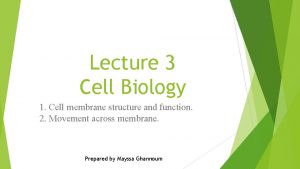
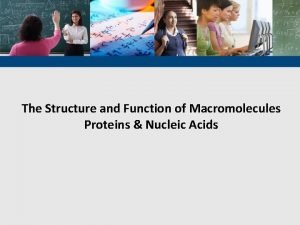
![Beta] Beta]](https://slidetodoc.com/wp-content/uploads/2020/09/657080_a4409c7c0464b8d1f634c79c1028ad3a-300x225.jpg)
